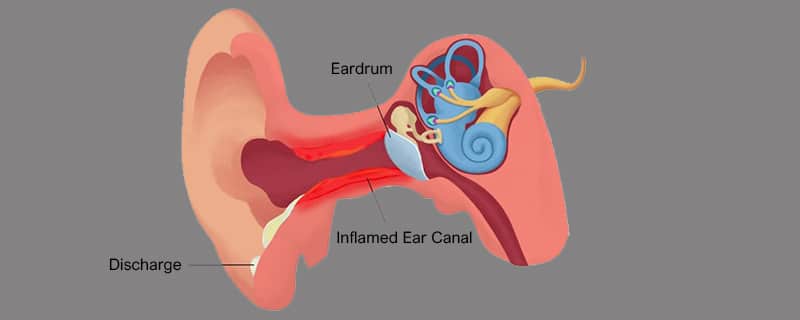
Outer Ear Infections (Otitis Externa)
One of the more common types of ear infection also known as otitis externa. It can clear up relatively quick with correct treatment and should clear up within a few days. Can sometimes take months to clear.Lanarkshire Hearing Centre will write you a GP referral if we find otitis externa or you show the following symptoms:
Symptoms
Pain in the ear
Redness in your ear
Swelling in your ear canal
Temporary hearing loss
Fluid or pus like fluid coming from the ear
Chronic Otitis Externa (Lasting more than a few weeks) symptoms
Constant itching in your ear and ear canal
Moving your ear cause discomfort but not as sore as acute otitis media
Watery discharge
Skin building up in the ear canal causing a blockage which can affect the hearing. Also known as stenosis.
Causes
| ✓ | Mainly bacterial |
| ✓ | Can be caused by fungal infection |
| ✓ | Irritation and excessive scratching |
| ✓ | Excessive self-cleaning with cotton buds |
| ✓ | Eczema in or around your ear canals |
| ✓ | Regular exposure to water in the ear |
Some ear wax softeners are believed to cause or certainly irritate otitis externa particularly those with hydrogen peroxide.
Otitis externa is very common type of ear infection. Your GP will give you drops which tend to clear it within a few days although some cases last for months or longer, but this is less common.
Precautions to prevent against otitis externa
| ✓ | Avoid cotton buds in your ears!!! Nothing smaller than an elbow! The skin inside your ear canal is very thin and at parts on bone. It’s very easy to irritate or lift the skin exposing it to infection. |
| ✓ | If you keep itching your ears with your fingers again you may break the skin and cause a route to infection. |
| ✓ | If you swim a lot, consider the use of ear plugs. Custom fit swimming ear plugs will keep your ears dry and will be worthwhile investment for people who do a lot of swimming. |
| ✓ | If possible, avoid getting any shampoo water or soap in your ears when bathing. |
If you have the symptoms what should you do? First of all contact your GP and explain the symptoms
If you have the above symptoms and you attend Lanarkshire Hearing Centre we will refer you to your local GP with a letter.
Avoid water in the ear. Perhaps wear some protection when showring like a shower cap.Remove anything that might plug your ear or get in the way such as hearing aids jewellery or custom fitted ear moulds
The NHS information website recommends using paracetamol or ibuprofen to relieve any pain. Be aware though this is not the correct course for everyone, and you should always read the literature that comes with the product and always check with the pharmacist GP or nurse practitioner.
Sometimes Otits Externa can take the form of a boil in the ear. To ease pain here a warm flannel or cloth placed over the swollen and sore area can help heal faster.
Treatments your GP surgery may provide
Your GP practice or nurse practitioner will most likely provide you with ear drops. These will be applied a few times a day for a week long period.These are the most common types of drops to treat otitis externa and may be given alone or in combination:
| ✓ | Antifungal ear drops – Treats any fungal infection that may be present |
| ✓ | Corticosteroid ear drops – Helps reduce the swelling in the ear canal |
| ✓ | Acidic ear drops – Helps kill of any underlying bacteria |
| ✓ | Antibiotic ear drops – Treats any underlying bacterial infection that may be present |
How to apply ear drops to the ear canal
Ear drops are only as effective as their application allows them to be.
You will be shown how to apply your ear drops along with instructions within the packet.
If you can it will be more efficient if someone else applies your ear drops.
Here is the best procedure
| ✓ | Remove debris from the outer ear (do not go in the ear canal) with some cotton wool. |
| ✓ | Gently warm the ear drops in your hands for a few minutes. Cold er drops can cause dizziness. |
| ✓ | Lie on your side with the treatment ear upmost. Drop the ear drops directly into the ear canal. You should feel them running down. |
| ✓ | Gently manipulate your pinna (The part of your ear stuck to the side of your head), by moving it in a round motion. This will help the drops navigate the bends in your ear canal and allow any trapped air out. |
| ✓ | Stay on your side and allow the ear drops to work into the canal. Allow them to work for at least 5 minutes. |
| ✓ | Now leave your ear open and keep if free from water and chemicals such as hairspray etc. |
